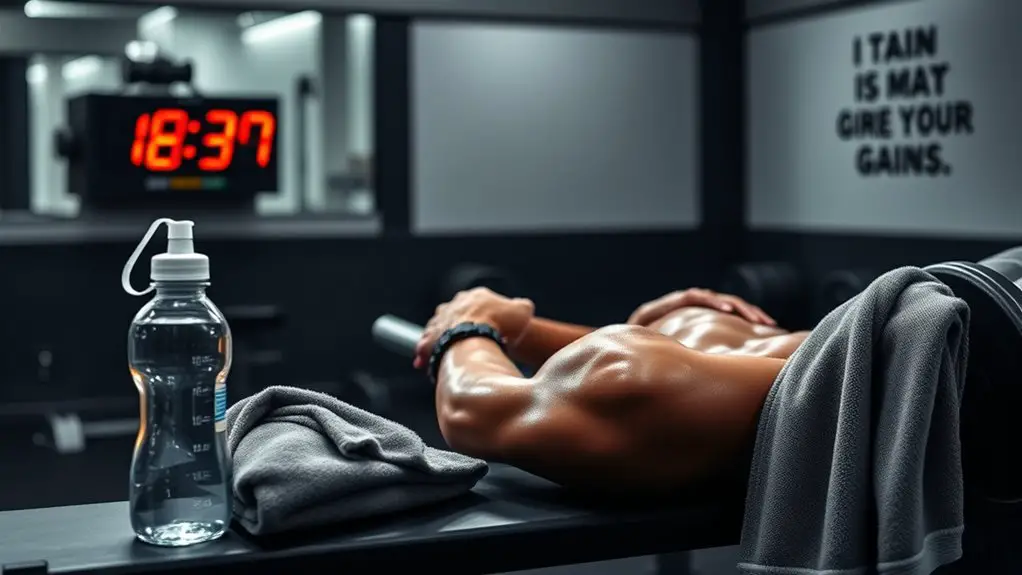How to Use Rest Periods Wisely for Maximum Gains

To use rest periods wisely for maximum gains, prioritize both active and passive recovery. Take 2 to 5 minutes for intense strength workouts or 30 to 90 seconds for hypertrophy. Consider light activities like stretching or mobility exercises during rests to keep blood flowing and reduce soreness. Avoid mistakes like idleness or negative thoughts, as they hinder recovery. By fine-tuning these practices, you can boost performance and enhance results. There’s so much more to discover about optimizing your training!
Understanding the Importance of Rest Periods

When you’re pushing your limits in the gym, it’s easy to overlook the vital role rest periods play in your progress. You might think that the more you train, the better your results will be, but that’s not the whole story. Rest periods are important for muscle recovery, allowing your body to repair and grow stronger. Without proper rest, you risk overtraining, which can hinder your performance enhancement instead of boosting it.
Incorporating adequate breaks means giving your muscles time to rebuild, ensuring you hit your next workout feeling fresh and ready to conquer. Remember, strength isn’t just about pushing harder; it’s about working smart too. So, don’t underestimate the power of a well-timed rest. Embrace those moments, and you’ll not only enhance your performance but also maximize your gains over time. Balance is key, and rest is a vital part of your training journey!
Different Types of Rest Periods and Their Benefits
While you might think rest periods are just downtime, they actually come in various forms, each with unique benefits that can enhance your training outcomes. The two main types of rest are active and passive rest. Active rest involves light activity, like walking or stretching, keeping your muscles engaged while allowing recovery. This type can boost blood flow and reduce soreness. On the other hand, passive rest means complete relaxation, allowing your body to fully recharge before tackling your next set. It’s essential for muscle recovery and strength gains.
There are also intra-set and inter-set rests; intra-set is the brief pause between reps, while inter-set is the longer break between different exercises. Each of these types of rest has its own benefits, contributing to improved performance, better endurance, and enhanced muscle growth. By understanding and strategically implementing these types of rest, you can maximize the benefits of rest in your training routine.
How Long Should Your Rest Periods Be?

Knowing the different types of rest periods is just the first step; understanding how long to rest is key to maximizing your gains. The ideal rest duration largely depends on your workout intensity and goals. For high-intensity strength training, aim for 2 to 5 minutes between sets. This allows your muscles to recover fully, enabling you to lift heavier weights during subsequent sets.
If you’re focusing on hypertrophy, a shorter rest period of 30 to 90 seconds can keep your muscles under tension, promoting growth. For endurance activities, resting 30 seconds to a minute may suffice, as the intensity is lower.
Listen to your body; it’s your best guide. Adjust your rest based on how you feel and the demands of your workout. By fine-tuning your rest periods, you’ll maximize your performance and see significant progress in your fitness journey!
Active Recovery: Enhancing Your Rest Time
Active recovery can be a game-changer for your workout routine, especially during those rest periods between sets. Instead of sitting still, try incorporating active recovery techniques like light stretching, foam rolling, or mobility exercises. These activities keep your blood flowing, helping to reduce muscle soreness and improve your overall performance.
The benefits of mobility during these breaks are immense. It enhances flexibility, increases range of motion, and prepares your muscles for the next round of effort. By staying engaged in light movement, you’re also mentally preparing yourself for the upcoming challenge.
Common Mistakes to Avoid During Rest Periods

Many people overlook the significance of how they spend their rest periods, which can lead to missed opportunities for improvement. One common mistake is not using proper resting techniques. Instead of sitting idle or scrolling through your phone, focus on active recovery strategies, like light stretching or deep breathing. This keeps your body engaged while promoting blood flow.
Another pitfall is allowing negative psychological effects to creep in. If you’re constantly worrying about your performance, it can hinder your recovery. Practice mindfulness or visualization techniques during your breaks to maintain a positive mindset.
Lastly, don’t forget to time your rest periods appropriately. Too short can lead to fatigue, while too long can diminish your workout intensity. By avoiding these mistakes and being intentional with your rest, you’ll maximize gains and enhance your performance in the long run. Stay focused, stay motivated, and make every second count!
Frequently Asked Questions
Can Rest Periods Improve Mental Focus During Workouts?
Absolutely, rest periods can enhance your mental focus during workouts. When you take short breaks, you give your brain a chance to reset, leading to improved mental clarity. This clarity helps you maintain higher workout intensity, allowing you to push through tougher sets. By consciously incorporating rest into your routine, you’re not just preserving energy; you’re sharpening your focus, making each rep count. So, don’t underestimate the power of those brief pauses!
How Do Rest Periods Affect Muscle Growth Over Time?
Rest periods play a vital role in muscle growth over time. When you allow your muscles to recover, you’re giving them the chance to repair and strengthen. This recovery time can also help improve your training frequency, enabling you to push harder in subsequent workouts. Remember, it’s not just about lifting weights; it’s about how well you manage your recovery. So, don’t skip those rest days—they’re essential for building the physique you want!
Should My Nutrition Change During Rest Periods?
Imagine your body as a garden. Just like plants need nutrients to flourish, your muscles need proper nutrition during rest periods. Don’t let your protein intake fall short; it’s the fertilizer that helps your garden grow strong. Meal timing matters too. Eating balanced meals at strategic times keeps your energy up and supports recovery. So, nurture your garden wisely—adjust your nutrition to guarantee your hard work in the gym blossoms into impressive gains!
Can I Do Light Exercises During Longer Rest Periods?
Absolutely, you can do light exercises during longer rest periods! Incorporating active recovery, like light cardio, can keep your blood flowing and help reduce muscle soreness. Think about activities like walking, cycling, or gentle stretching. Not only does this maintain your energy levels, but it also keeps you mentally engaged. Just remember, the goal is to recover, so keep it light and enjoyable. You’ll come back stronger and ready to tackle your next workout!
How Do Age and Fitness Level Influence Rest Period Needs?
Age and fitness level play a significant role in determining your rest period needs. As you age, your body may require longer recovery times due to slower recovery rates and reduced muscle elasticity. Likewise, your fitness adaptations influence how quickly you bounce back. If you’re a beginner, longer rest might benefit you more, while seasoned athletes might thrive on shorter breaks. Listen to your body, and adjust your rest periods to optimize your training.





